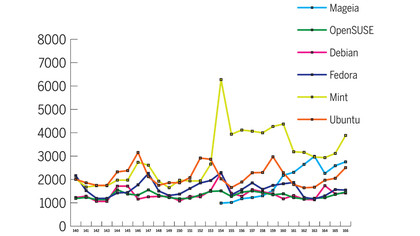How Mint became one of the most popular Linux distros
We speak to the creator of Mint, Clem Lefebvre
We have already seen many PCs sold with a Linux distro on board, specifically Dell's contribution with Ubuntu pre-installed. However, they aren't Linux Mint. Here, we have a unit that can be plugged in and played. As well we know, and have already mentioned, with Mint's inclusion of media specific codecs and libraries, you could quite easily order a brace of MintBoxes, hook them up to a reasonably-sized TV and start streaming media from around the network. In terms of ease of use, therefore, they require very little effort to set up.
New model ARMy
But what of the future of the MintBox, or the next generation of Mint-installed units? As Clem stated in his recent blog regarding the MintBox: "The partnership with CompuLab is likely to extend to the IntensePC in the future (which features the Intel i7)".
Certainly the added power behind Intel's flagship processors would be an incredible asset to the end user, particularly if the user's needs extend to video editing or the playing of games. But the future of the Linux-based PC seems to be heading down the path of the ARM CPU, at least for the moment. Could we possibly see a future where ARM and Mint, excuse the pun, go hand-in-hand?
It's certainly food for thought, and makes an interesting topic of conversation; after all, we've seen how popular the Raspberry Pi has been since its launch; could Mint partner with the Pi Foundation, perhaps?
Top of the pops?

Lies, damn lies and statistics
If you browse on over to the Wikimedia Traffic Analysis Report for Operating Systems, you will find an "overview of page requests by operating system, based on the user agent information that accompanies the server requests," as the site so eloquently explains. The numbers shown there are not to be considered as the final word in who is more popular than whom; but in the grand scale of things, we can see some indications of how popular Linux Mint is becoming.
The breakdown from a snapshot from 19 October to 31 October 2011 shows us that 17.3 million requests were sent from Linux Mint PCs, which comes to just 0.01% of the total, below Ubuntu, Mandriva, Debian, Fedora and OpenSUSE. In addition to these numbers, the results for this year are 11.2 million for Linux Mint, and 1,100 million for Ubuntu; with Debian, SUSE and Fedora now above Mint in the rank.
Get daily insight, inspiration and deals in your inbox
Sign up for breaking news, reviews, opinion, top tech deals, and more.
The Distrowatch story
For an enlightening contrast, visit Distrowatch.com. Scroll down the page and, as most of you will no doubt be aware, you will come across a Page Hit Ranking. At the very top of this list, leading by quite a margin, you will see Mint; but what does this mean?
The Distrowatch page rankings are, as Distrowatch itself states: "a light-hearted way of measuring the popularity of Linux distributions and other free operating systems among the visitors of this website. They correlate neither to usage nor to quality, and should not be used to measure the market share of distributions. They simply show the number of times a distribution page on DistroWatch.com was accessed each day, nothing more."
So, while Linux Mint is storming ahead of the competition, as it were (although as we know, there is no competition in Linux, right?), this is purely the number of times that the Mint link has been hit - be that by accident or just casual browsing.
Whatever metric you choose to measure the rise of Mint, it's clear that it's doing a grand job, and we can expect to see even more of it in the near future. Cheers Clem: keep up the good work.